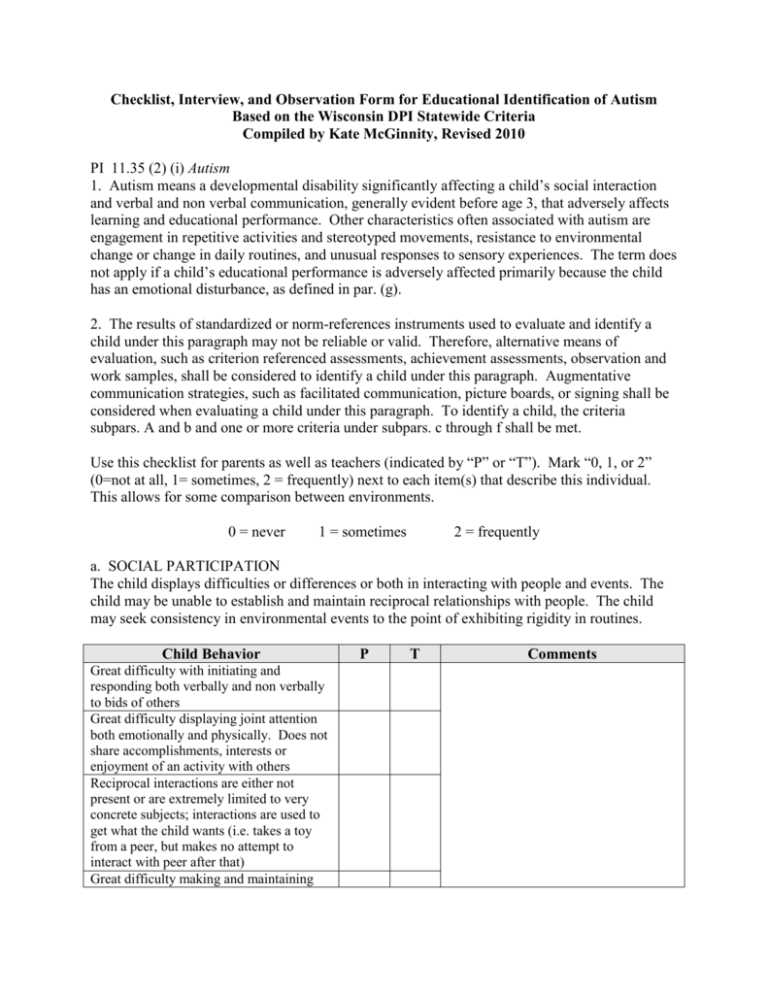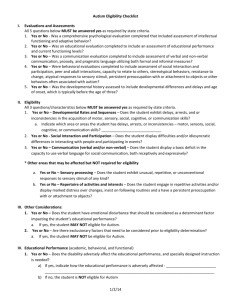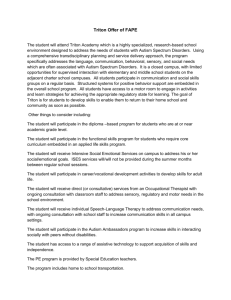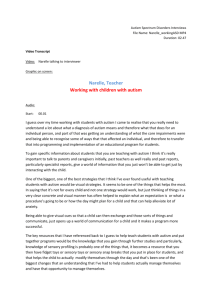Checklist, Interview, and Observation Form for Educational
advertisement

Checklist, Interview, and Observation Form for Educational Identification of Autism Based on the Wisconsin DPI Statewide Criteria Compiled by Kate McGinnity, Revised 2010 PI 11.35 (2) (i) Autism 1. Autism means a developmental disability significantly affecting a child’s social interaction and verbal and non verbal communication, generally evident before age 3, that adversely affects learning and educational performance. Other characteristics often associated with autism are engagement in repetitive activities and stereotyped movements, resistance to environmental change or change in daily routines, and unusual responses to sensory experiences. The term does not apply if a child’s educational performance is adversely affected primarily because the child has an emotional disturbance, as defined in par. (g). 2. The results of standardized or norm-references instruments used to evaluate and identify a child under this paragraph may not be reliable or valid. Therefore, alternative means of evaluation, such as criterion referenced assessments, achievement assessments, observation and work samples, shall be considered to identify a child under this paragraph. Augmentative communication strategies, such as facilitated communication, picture boards, or signing shall be considered when evaluating a child under this paragraph. To identify a child, the criteria subpars. A and b and one or more criteria under subpars. c through f shall be met. Use this checklist for parents as well as teachers (indicated by “P” or “T”). Mark “0, 1, or 2” (0=not at all, 1= sometimes, 2 = frequently) next to each item(s) that describe this individual. This allows for some comparison between environments. 0 = never 1 = sometimes 2 = frequently a. SOCIAL PARTICIPATION The child displays difficulties or differences or both in interacting with people and events. The child may be unable to establish and maintain reciprocal relationships with people. The child may seek consistency in environmental events to the point of exhibiting rigidity in routines. Child Behavior Great difficulty with initiating and responding both verbally and non verbally to bids of others Great difficulty displaying joint attention both emotionally and physically. Does not share accomplishments, interests or enjoyment of an activity with others Reciprocal interactions are either not present or are extremely limited to very concrete subjects; interactions are used to get what the child wants (i.e. takes a toy from a peer, but makes no attempt to interact with peer after that) Great difficulty making and maintaining P T Comments friends Child Behavior P T Comments Play tends to be unimaginative, repetitive, or solitary Great difficulty in describing friendship in an age appropriate manner Great difficulty following the give and take of conversation Can be withdrawn or talk to self, or continue a running commentary or monologue, does not notice if others are listening Is unable to “tune into” the class and the social environment, easily distracted by others in classroom (visual or auditory stimuli) Great difficulty mixing with or playing with peers, may interact more readily with adults Great difficulty with flexibility within play themes (i.e. following own set play sequence without deviating from routine) Very rule bound, may remind others of rules; may “police” others’ behavior Appears to be more interested in objects than people, completely avoids social contact with others Great difficulty responding to consolation from others Great difficulty in understanding another’s perspective Expects others to know his/her thoughts, experiences and opinions Appears to lack intuition, appearing naïve Lacks an anticipatory response Demonstrates difficulty learning and using rules of social interaction. Does not understand the implications of social behavior or conventions, or codes of conduct; may make statements, demonstrate behavior that is offensive to others, say things that are socially inappropriate (i.e. “you’re fat” or “you’re 2 really old”) Child Behavior P T Comments Lacks empathy (i.e. the intuitive understanding of another person’s feelings) Needs excessive reassurance, especially if things are changed or go wrong Is indifferent to peer pressure, does not follow crazes or understand current trendy language Does not like to participate in competitive sports, games or activities Treats strangers the same as familiar people (will go with or hug a stranger without question) Little or no meaningful eye contact, appears to stare, blank look Complete disregard or lack of appreciation of danger (i.e. running into the street, climbing up on high cupboards, touching hot stove etc.) Additional Comments: b. COMMUNICATION The child displays difficulties which extend beyond speech and language to other aspects of social communication, both receptively and expressively. The child’s verbal language may be absent or, if present, lacks the usual communicative form which may involve deviance or delay or both. The child may have a speech or language disorder or both in addition to communication difficulties associated with autism. Child Behavior P T Comments Demonstrates a delay in the pragmatics of language Demonstrates a delay in the use non verbal language, clumsy body language, limited or inappropriate facial expression, peculiar or stiff gaze. Great difficulty reading non verbal message in communication partner 3 Child Behavior P T Comments If using verbal language, great difficulty using speech to communicate wants and needs and other functions Echolalia, repetition of words or phrases (i.e. may repeat exactly what has been said to him/her) Speech is overly formal, precise or pedantic (scholarly in a dull or narrow way) Uses speech in a repetitive manner, perseverates on a favorite topic, describes technical things in great detail, uses technical jargon Great difficulty using spontaneous language Uses scripted language (i.e. may repeat commercials, items from a book, song lyrics, or lines from movies over and over or at inappropriate times; May say the same thing in the same or similar context) Uses a loud unmodulated voice, odd prosody or peculiar vocal quality; immature inflection and pitch (very singsong, monotone, robotic, high pitched or other obvious deviation) Non logical use of pronouns, pronoun reversals, or no use of pronouns (Sally says, “Sally wants cookie” instead of “I want cookie) Is hyper verbal Expresses emotions in a unconventional manner Great difficulty taking turns in conversation, topic maintenance or use of referents Interprets what is said literally Does not respond to or interprets social gestures / information Mute or little or non language; Relies on gestures, signs, or pointing; may tantrum to get things or do things; may grab people and pull to what is wanted. 4 Child Behavior P T Comments Does not initiate conversation, fails to use greetings, does not ask questions Use of picture communication, signs, or with facilitation demonstrates a higher level of understanding or communication other than verbal language Failure or great difficulty with abstract concepts or reasoning, very rote or literal, may make topically related response that is not accurate to actual conversation (i.e. Teacher: “We must learn to wait in line at McDonald’s” Child: “Chicken McNuggets are good!”) May be able to engage in conversation with adults, but is unable to with peers, can be bossy or critical of others without regard to social implications Difficulty disengaging thoughts from language, says exactly what is on his or her mind (“you’re fat” or “you’re really old”) Appears disinterested in the other person’s side of the conversation Failure to repair the conversation or seek clarification Has been previously labeled as deaf Describe his/her auditory processing time: Additional Comments: c. DEVELOPMENTAL RATES AND SEQUENCES The child exhibits delays, arrests or regressions in motor, sensory, social or learning skills. The 5 child may exhibit precocious or advanced skill development, while other skills may develop at normal or extremely depressed rates. The child may not follow normal developmental patterns in the acquisition of skills. Child Behavior P T Comments Developmental facts that do not seem to “fit” together, some type of discontinuity in development (e.g. may have progressed fairly appropriately until about age two or three, then regression began) Demonstrates skills of high proficiency offset by challenges that don’t seem to ‘fit’ developmental profile (e.g. may be adept at calculus yet not be able to remain continent) Uneven profile of skills - social, motor, sensory and or learning are unevenly developed (i.e. very good math skills, very poor reading skills, good ability to read and no comprehension skills, math skills above grade level while creative writing skills are several years delayed) Hyperlexia (defined as a precocious ability to read words far above what is expected at that age, or an intense fascination with letters or numbers) Exhibits precocious or advanced skill development in some areas, while other skills develop at a normal or extremely depressed rate Does not follow a predictable, “normal” pattern of development, there are delays, arrest or regressions in motor, sensory social or learning skills Additional Comments: 6 d. COGNITION The child exhibits abnormalities in the thinking process and in generalizing. The child exhibits strengths in concrete thinking while difficulties are demonstrated in abstract thinking, awareness and judgment. Perseverant thinking and impaired ability to process symbolic information may be present. What are the student’s learning strengths? (look at visual special information, concrete rules and information, motor memory, rote memory?) What are the student’s learning weaknesses? (look at understanding symbols, understanding means to end and cause and effect, time based information, abstract concepts and information, imitation, ability, generalization) Child Behavior P T Comments Has a gestalt processing style Has a difficult time identifying relevant cues Verbal IQ is equal to or exceeds performance IQ Has a particular talent in art, music, or mathematics Perseveration (to be stuck thinking about or doing one thing over and over) on topics using very concrete facts, but at the same time having an inability to generalize or think abstractly about topics, fascinated with a particular topic or avidly collects information or statistics of interest (i.e. walking encyclopedia) Has long term memory for events or facts (or, even, photographic in memory) Inability to comprehend abstract ideas or commands Narrow range of interests, inability to play creatively; Or, may appear to play creatively but the script never changes & little or no imagination is apparent in play schemes Difficulty or inability to process symbolic information (e.g.does not seem to have an internal sense of time) 7 Has a difficult time demonstrating flexibility in rule structure Additional Comments. SENSORY PROCESSING The child exhibits unusual, inconsistent, repetitive or unconventional responses to sounds, sights, smell, tastes, touch or movement. The child may have a visual or hearing impairment or both in addition to processing difficulties associated with autism. Child Behavior P T Comments Has unusual sleep patterns (i.e. difficulty falling asleep, waking frequently at night etc.) Experiences sensory input differently (more or less sensitive than typical peers) Extremely passive or hyper Has extreme changes in arousal level Handles objects in an unusual way Demonstrates self stimulatory behaviors – stereotyped movements: rocking, spinning, darting, lunging, hand-flapping, pacing Auditory: attention to a self induced sound, non response or over-reaction to noises of varying levels Visual: close scrutiny of visual details, non-use of eye contact, staring, prolonged regarding of object, attention to illumination (lights), use of peripheral vision, etc. Olfactory or gustatory: repetitive sniffing of objects, specific food preferences or aversions, gagging on certain foods, difficulty swallowing not associated with a physical problem, pica - eating inedible objects Tactile: over / under responsive to pain, touch, or temperature, prolonged rubbing of surfaces, refuses to keep shoes on, avoids walking on grass with bare feet 8 Child Behavior P T Comments Vestibular: over / under responsive to gravity, whirling, spinning, bumping into things, need to lift or push heavy objects Need for: tight hugs, soft touch, deep pressure (sometimes manifested in physical aggression or pushing or pulling on others) ear mufflers, sun glasses Combinations of sensory input overstimulates: unable to look at while listening to someone, cannot sing at the same time others are singing, unable to follow directions while watching something Additional Comments: f. CHALLENGING BEHAVIOR The child displays marked distress over changes, insistence on following routines, and a persistent preoccupation with or attachment to objects. The child’s capacity to use objects in an age appropriate or functional manner may be absent, arrested, or delayed. The child may have difficulty displaying a range of interests or imaginative activities or both. The child may exhibit stereotyped body movements. Child Behavior P T Comments Is dependent on routine, perseverates on the sameness of the environment (i.e. must have same activity at the same time each day, or particularly aware of the sequence of events, expecting them to happen that way each time, may panic or tantrum if they do not) Becomes distressed with changes in routines – gets stuck in behavior, may refuse to do anything until routine is followed, obsessive / compulsive behavior Focuses on specific objects or people, 9 seemingly passionate or even obsessive (i.e. spinning wheels on a car, lining up toys, moving them back and forth, etc.) Has a limited range of interest Child Behavior P T Comments Is aggressive or self abusive rising out of challenges in understanding the environment or world (i.e. head banging, picking at skin, hitting self, biting hand etc.) May appear inflexible to neurotypical people Mood swings, tantrums for no apparent reason, crying, giggling, laughing without apparent reason, inappropriate fears Has difficulty with transitions between materials, people, environment or activities Additional Comments: Updated by Kate McGinnity (2010) (Adapted from Kate McGinnity and Tiffany Yocum, 2004) Sources: 1. WI DPI State Autism Criteria 2. Graczyk, McGinnity, Negri & Shoultz (1995) "Characteristics of and Support Strategies for Individuals with Autism" (A handout) 3. Tanguay, P. & Lourde, C. (2002) "Affective Reciprocity & ASD" (Conference notes) 4. Milwuakee Public Schools’ Autism Spectrum Checklist, 2004 10







